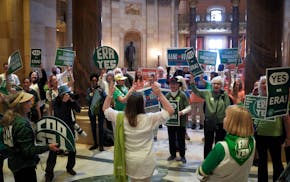Opinion editor's note: Editorials represent the opinions of the Star Tribune Editorial Board, which operates independently from the newsroom. This editorial was written on behalf of the board by Star Tribune Opinion intern Noor Adwan, a 2023 graduate of the University of Minnesota.
•••
Last month, President Joe Biden unveiled the American Climate Corps, a New-Deal-inspired service program the White House says will employ 20,000 in conservation, clean energy and climate resilience in its first year.
Concurrent with that announcement, Minnesota and five other states issued a joint statement detailing their intent to create parallel state-level climate corps programs. Participants in state-level programs, which will be funded through both AmeriCorps and philanthropy, will earn $30,000 if they work full-time during their term.
American Climate Corps members will be paid — though it is not clear how much — to deploy clean energy technology, aid in restoration efforts, build communities' resilience to climate change and otherwise advance environmental protection goals. The corps was also designed to create pathways for members to secure good-paying jobs in clean energy and climate following their completion of the program.
"We're excited about this program," Aaron Klemz, chief strategy officer at the Minnesota Center for Environmental Advocacy, told an editorial writer. "It's really pointing toward a critically important component of this clean energy transition that we're in the middle of, which is workforce development."
The experience and skills members will gain by participating in the corps will be crucial in filling the fast-growing number of green jobs in Minnesota, Klemz said — a boom that is partly attributable to the Inflation Reduction Act passed last year. At the end of 2022, nearly 60,000 Minnesotans were employed by clean energy businesses, according to a Clean Energy Economy MN (CEEM) report. Clean energy jobs grew 50% faster than the state's overall job growth that year, and CEEM expects that growth to continue as a result of state and federal policies incentivizing energy efficiency improvement.
"We're expecting to add another 30,000 to 40,000 clean energy and energy efficiency jobs [in Minnesota] in just the next five or six years," Klemz said. "And it's going to be really important to have a training pathway for young people who want to go into those careers."
Something a climate corps could address here that would be especially important is residential energy emissions, which continue to rise in Minnesota, Klemz said. Greenhouse gas emissions from residences have risen 14% over the last 15 years, according to a Minnesota Pollution Control Agency report. These emissions are largely due to natural gas, which is used to heat homes and power some appliances.
"Luckily, there are a lot of easy, straightforward ways to solve this problem, mostly involving insulation and low-tech kinds of approaches," Klemz said. "But we're going to need a massive workforce for that."
The creation of the American Climate Corps also complements similar work that is well underway in Minnesota to fight climate change. ServeMinnesota, a Minneapolis-based nonprofit that oversees AmeriCorps programs across the state, offers Climate Impact Corps, Conservation Corps Minnesota, Minnesota Energy Climate Corps and Minnesota GreenCorps, yearlong service programs designed to employ people in conservation efforts and train them for future careers.
"In many ways, this announcement of an American Climate Corps is an affirmation of the great work that's already happened here in Minnesota and elsewhere," Peter Nelson, ServeMinnesota vice president of impact and innovation, told an editorial writer.
ServeMinnesota is still determining exactly what the state-level climate corps might look like, Nelson said, but it will likely involve bridging the gap between its existing climate-related service programs and sharing resources between them.
Minnesota's swiftness in jumping on board with the federal climate corps program is indicative of our state's admirable willingness to lead and be ambitious on climate. But it's worth reiterating that this work has already been started here — ServeMinnesota's Conservation Corps became an AmeriCorps program in 1995, and GreenCorps was established in 2009.
Regardless, it is encouraging to see Biden make good on something he called for in his first week of office — even if he had to use executive authority to do so. The creation of the American Climate Corps is a solid step in the direction of ensuring we have the skilled workforce we need to execute a clean energy transition.
"We set ourselves some really ambitious goals to reduce greenhouse gas emissions," Klemz said. "And it's going to take the development of a skilled, diverse and powerful workforce in order to reach our goal."
To learn more about the American Climate Corps, visit whitehouse.gov/climatecorps. To learn more about ServeMinnesota's climate-related service programs, visit serveminnesota.org.

Readers Write: State flag, college sports, theft prevention
It's not funny: The disheartening state of creative and cultural nonprofits in Minnesota

Universities mirror society and the lack of trust in institutions



